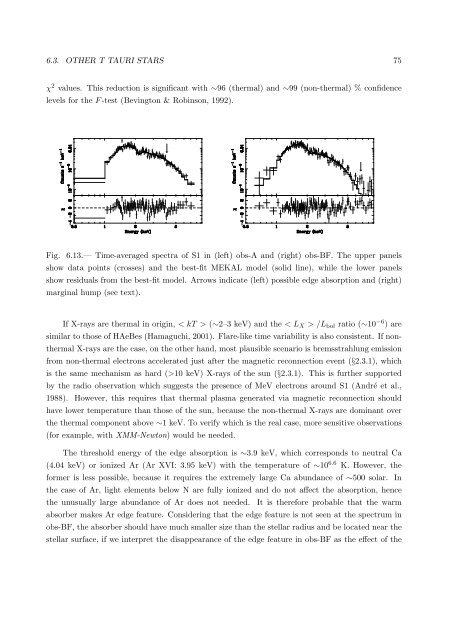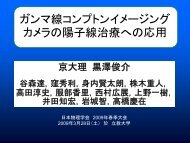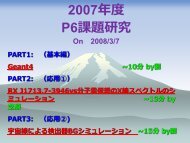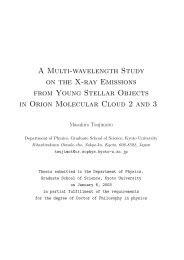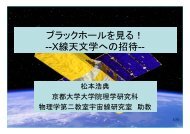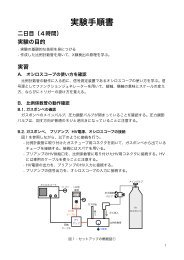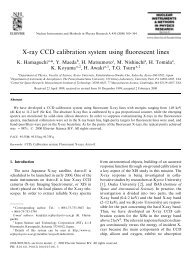X-ray Study of Low-mass Young Stellar Objects in the ρ Ophiuchi ...
X-ray Study of Low-mass Young Stellar Objects in the ρ Ophiuchi ...
X-ray Study of Low-mass Young Stellar Objects in the ρ Ophiuchi ...
You also want an ePaper? Increase the reach of your titles
YUMPU automatically turns print PDFs into web optimized ePapers that Google loves.
6.3. OTHER T TAURI STARS 75χ 2 values. This reduction is significant with ∼96 (<strong>the</strong>rmal) and ∼99 (non-<strong>the</strong>rmal) % confidencelevels for <strong>the</strong> F -test (Bev<strong>in</strong>gton & Rob<strong>in</strong>son, 1992).Fig. 6.13.— Time-averaged spectra <strong>of</strong> S1 <strong>in</strong> (left) obs-A and (right) obs-BF. The upper panelsshow data po<strong>in</strong>ts (crosses) and <strong>the</strong> best-fit MEKAL model (solid l<strong>in</strong>e), while <strong>the</strong> lower panelsshow residuals from <strong>the</strong> best-fit model. Arrows <strong>in</strong>dicate (left) possible edge absorption and (right)marg<strong>in</strong>al hump (see text).If X-<strong>ray</strong>s are <strong>the</strong>rmal <strong>in</strong> orig<strong>in</strong>, < kT > (∼2–3 keV) and <strong>the</strong> < L X > /L bol ratio (∼10 −6 ) aresimilar to those <strong>of</strong> HAeBes (Hamaguchi, 2001). Flare-like time variability is also consistent. If non<strong>the</strong>rmalX-<strong>ray</strong>s are <strong>the</strong> case, on <strong>the</strong> o<strong>the</strong>r hand, most plausible scenario is bremsstrahlung emissionfrom non-<strong>the</strong>rmal electrons accelerated just after <strong>the</strong> magnetic reconnection event (§2.3.1), whichis <strong>the</strong> same mechanism as hard (>10 keV) X-<strong>ray</strong>s <strong>of</strong> <strong>the</strong> sun (§2.3.1). This is fur<strong>the</strong>r supportedby <strong>the</strong> radio observation which suggests <strong>the</strong> presence <strong>of</strong> MeV electrons around S1 (André et al.,1988). However, this requires that <strong>the</strong>rmal plasma generated via magnetic reconnection shouldhave lower temperature than those <strong>of</strong> <strong>the</strong> sun, because <strong>the</strong> non-<strong>the</strong>rmal X-<strong>ray</strong>s are dom<strong>in</strong>ant over<strong>the</strong> <strong>the</strong>rmal component above ∼1 keV. To verify which is <strong>the</strong> real case, more sensitive observations(for example, with XMM-Newton) would be needed.The threshold energy <strong>of</strong> <strong>the</strong> edge absorption is ∼3.9 keV, which corresponds to neutral Ca(4.04 keV) or ionized Ar (Ar XVI: 3.95 keV) with <strong>the</strong> temperature <strong>of</strong> ∼10 6.6 K. However, <strong>the</strong>former is less possible, because it requires <strong>the</strong> extremely large Ca abundance <strong>of</strong> ∼500 solar. In<strong>the</strong> case <strong>of</strong> Ar, light elements below N are fully ionized and do not affect <strong>the</strong> absorption, hence<strong>the</strong> unusually large abundance <strong>of</strong> Ar does not needed. It is <strong>the</strong>refore probable that <strong>the</strong> warmabsorber makes Ar edge feature. Consider<strong>in</strong>g that <strong>the</strong> edge feature is not seen at <strong>the</strong> spectrum <strong>in</strong>obs-BF, <strong>the</strong> absorber should have much smaller size than <strong>the</strong> stellar radius and be located near <strong>the</strong>stellar surface, if we <strong>in</strong>terpret <strong>the</strong> disappearance <strong>of</strong> <strong>the</strong> edge feature <strong>in</strong> obs-BF as <strong>the</strong> effect <strong>of</strong> <strong>the</strong>


